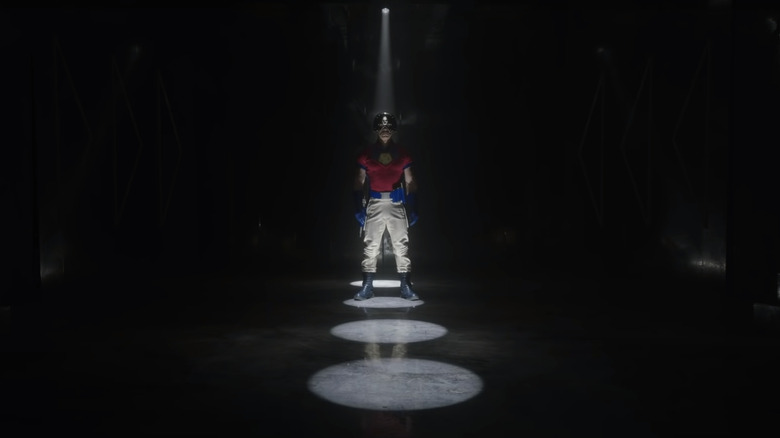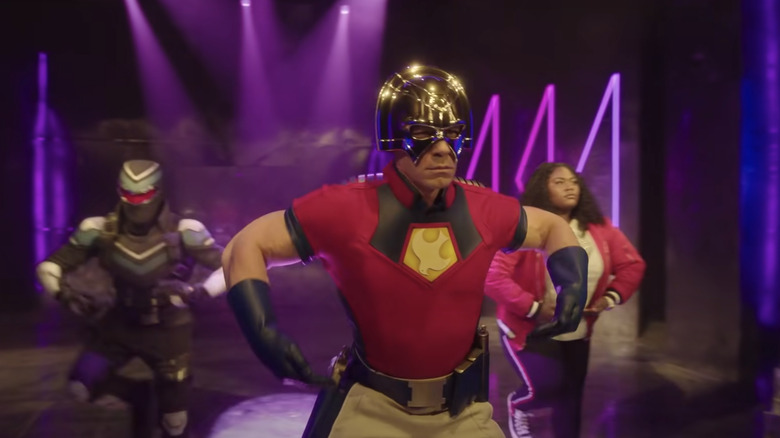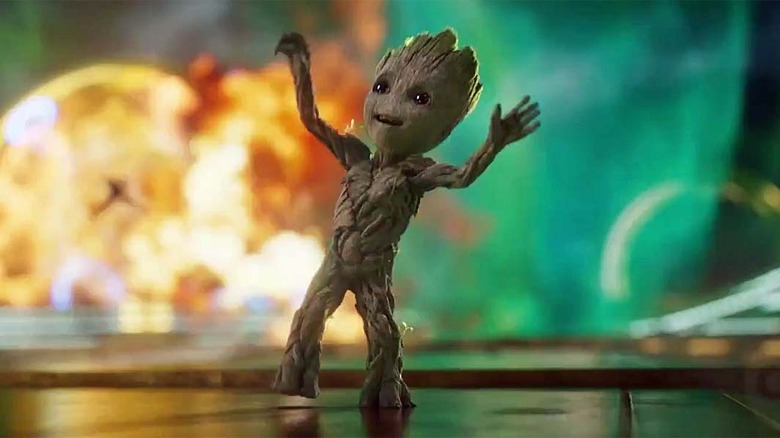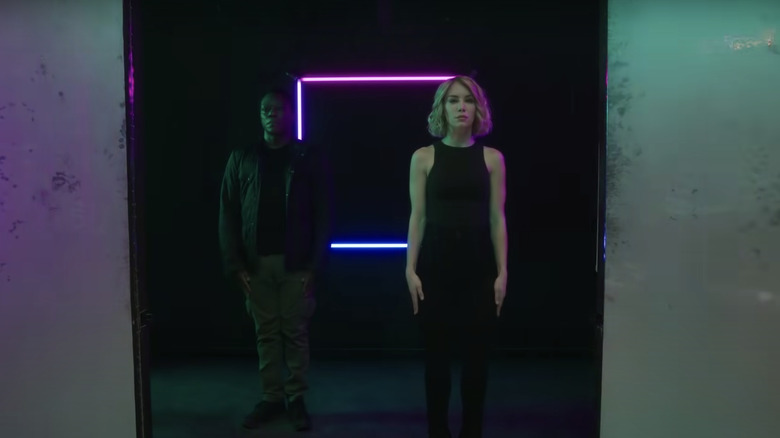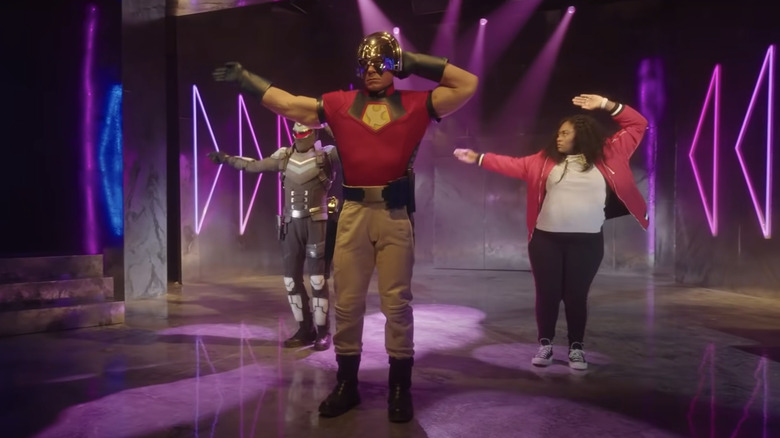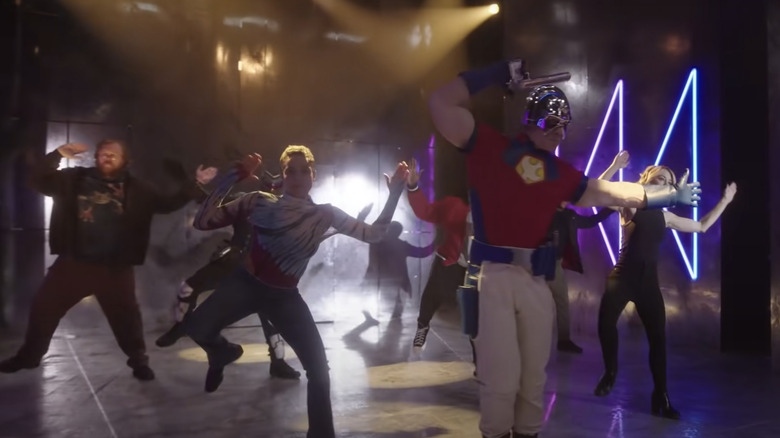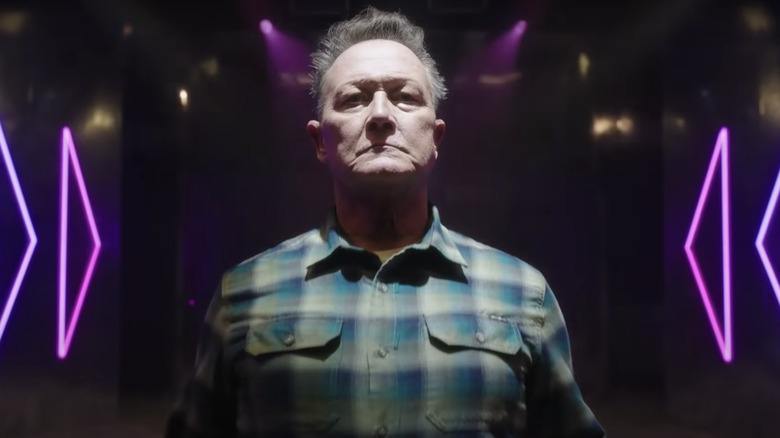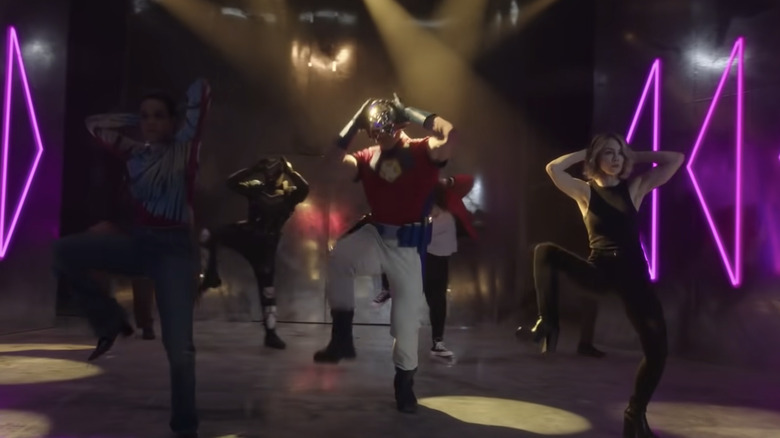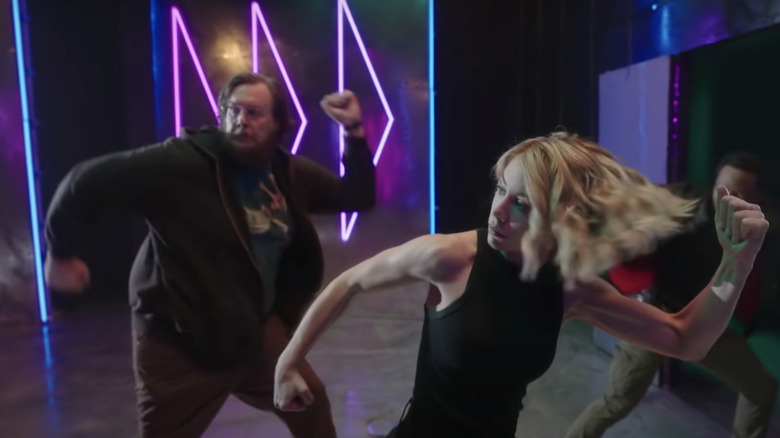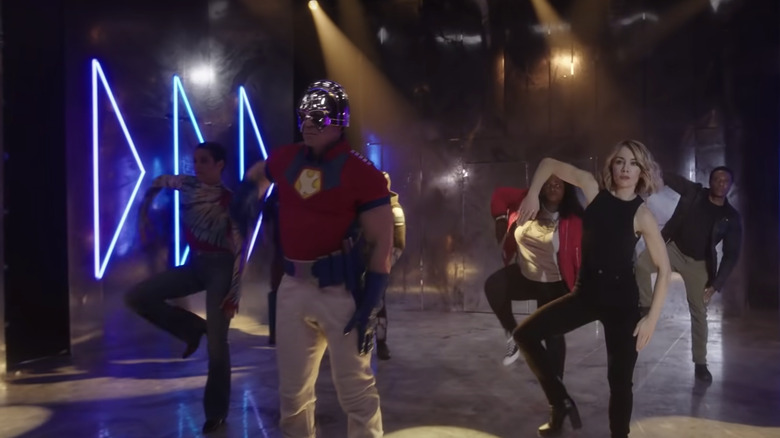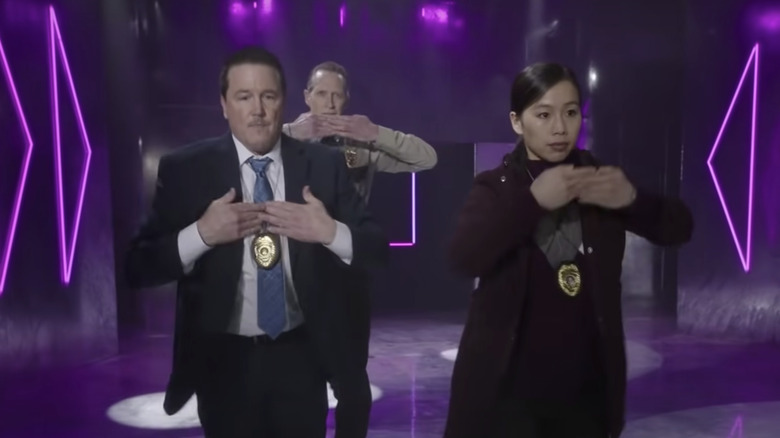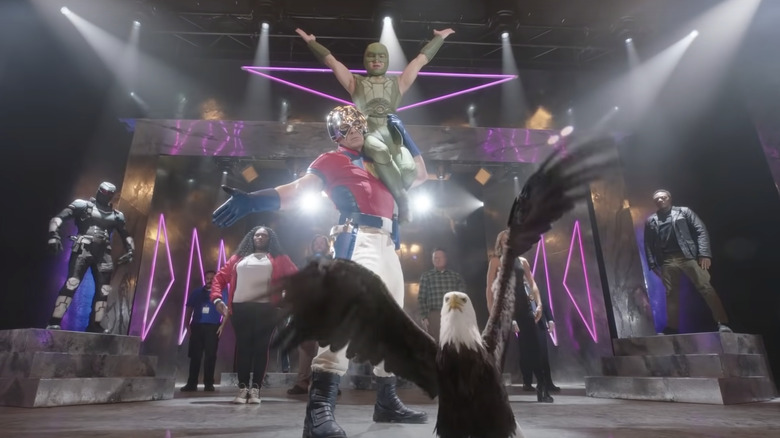Peacemaker Choreographer Explains How That Amazing Dance Sequence Came Alive [Interview]
HBO Max's "Peacemaker" has been on everyone's lips since the show debuted earlier this month, especially the masterful opening credits sequence featuring a stone-faced dance number starring the entire cast. Some people weren't sure what to make of this sequence, but it only takes a handful of views to become absolutely obsessed with the mesmerizing movements set to Wig Wam's "Do You Wanna Taste It." We couldn't get enough of this opening and vowed to learn absolutely everything about it. Which is why we sat down (over Zoom, obviously) to talk with Charissa-Lee Barton, the brilliant choreographer behind the addictive dance we're all learning to do in our living rooms.
Curious how the hell this dance came to be? Read on to learn absolutely everything that led to the best opening credits sequence of the year. Or maybe any year.
In The Right Place at the Right Time
You've choreographed so, so many things, did you ever imagine you'd be choreographing a dance for a James Gunn superhero series?
Never, never. Although, I ... It's funny because in, I think it was around August or September of 2020, and so everything was pretty shut down, and people weren't going anywhere, and my husband (actor Alan Tudyk) and I were in Vancouver. And I remember looking on a local website and it mentioned some of the things that are going on and there's a lot of show shoots, and I read James Gunn is in Vancouver and going, "Ah, cool. Wow, he'd be a really cool person to run into." And I had a kind of moment with it, as someone who loves his work, I thought that it'd be pretty neat. Plus, I was like, he doesn't know me, but I know Nathan Fillion who's known him for a really long time. And at the time I wasn't really fully aware that Alan [Tudyk] knew him either on a professional level. And so I kind of went, "Wow, there's some connections there, but who knows? But it would be really cool to know what he was working on." And then nothing came of it. But then three months later, I was going to pitch some ideas [through Zoom] that I had for this dance to him. And [...] it was like a seed was planted and then three months later, there I was talking to him, pitching to him through Zoom. It was a really cool little like, "Wow, that's interesting." I've always loved how he uses dance and how he integrates dance. I think that dance is generally underused. He's always been a person that finds a way to build it in. I guess the simple answer to your question is no way, I could never imagine getting to do this.
James Gunn Appreciates the Art of Dance
I like that you brought up how he incorporates dance because I'm just thinking about all of his movies right now, and even in his strictly horror fare, there are a lot of people that will express excitement via dance, even if it's just something small. So yeah, he's definitely somebody who understands and appreciates that form of expression.
Yeah. And I loved that he used his own moves for Groot, for the Baby Groot dance. I remember seeing that and going "Wow, that's awesome. I don't know of any other director that would do that. All right. Neat."
Right? So just based on my own knowledge of looking at the dance, and this is obviously no shade to anyone that's in it, you were clearly choreographing for a group of people with a wide variety of experience. How do you begin that process of figuring out things that are accessible for all involved? Because it looks like some of them definitely have some dance experience and then some people are movers, not dancers.
Yeah. I had to be organized with it. So I started by doing my own research on all of them. And I dug as deep as I could into the internet to find any kind of footage or any kind of reference to dance or movement for all of them. So like Rizwan [Manji] I learned had studied at AMDA [American Musical and Dramatic Academy], and I thought AMDA, I believe, has some movement classes, at a minimum, some movement classes. So I know he's had some experience. So, great! Check! And then I saw Danielle Brooks on "Lip Sync Battle" and she kind of moves around the audience and I was like, "Oh, Danielle can MOVE. She can dance." She's got a natural ability that I was like, "Cool. That's great." I knew that Jen [Holland] was a gymnast. So I kind of went through the list and tried to get a sense of how comfortable or uncomfortable they might be with movement. But I also knew that for non-dancers to be told that they're going to do a dance and then show up to rehearsals is very intimidating.
"I Want You All to Look Good"
Oh, god, yeah. Yeah.
So I had to take a little bit of a psychological approach to it as well. Like when they would come into the room, my intent was setting the tone of the room and the energy of the room as calm, and fun, and really positive. So that if they walked in, and pretty much all of them walked in with a little bit of that tension of like, "I don't know what we're about to do, but learning choreography is not easy," I would set the tone right up the bat with like, "I've made this very attainable. And I'll show you what I've done so far, and it may look complex, but as we begin to break it down into its component parts, you'll find that it's actually a lot more attainable than you think." So I set that tone right off the bat and I was like, "Look, I'm very cognizant of it all and I want you all to look good." And I think that calmed everybody down right off the top. That, and I would like to mention that they all showed up. What made a big difference was that they all showed up so committed to the idea and were so committed to learning and doing what they needed to do to get it.
I love that. It can be so scary, so I'm glad they really went for it.
I think that comes from just a level of being a pro, and they're all such pros, but it also came because they trust James [Gunn]. They have such a trust in him and his vision that I think it made it easier for them to then trust me, without really knowing anything about me. And that really smoothed the way. But having their commitment to the process was huge. It was huge. And I wasn't sure what to expect or if I could expect that. And that was another thing that I wanted to make sure, is also setting the tone that there's no room for, "Oh, I can't do that." It's, "You're going to do it and it's just a matter of finding a way to get there that's as painless, and as fun, and as hopefully joyful as enjoyable as possible." But then within that, we had very, very limited time because they're all in it, the whole show, so they were shooting all the time. I had to be very organized with it. And so I started with finding how the moves felt in my own body. So I listened to the song probably 100 times before I even moved, before I even started thinking about movement. [My process] was all [about] finding the deeper layers of the feeling of the song within the context of what James was looking for.
Yes, Alan Tudyk Knows the Choreography
Oh, fascinating.
Then I went into a room and I just started kind of like moving as simply as possible to find what felt appropriate in my own body. And then from there started kind of setting it while, keeping in mind that when I would start to get too complex, that I'd probably have to tone it down. But luckily I had my husband Alan present with me through a lot of it. Sometimes he would get home late and it'd be like 11 o'clock at night. I'd be like, "Hey, can you try something? I need to see if this is accessible to a non-dancer." Because it is hard for me to gauge sometimes. And he was such a willing partner. He was able to really help me find that line. As I feel like he was an actor non-dancer person.
Ha! I love that!
And then, once I established a foundation for it and had gotten feedback from James [on] what I had filmed myself doing and what I had filmed Alan and I doing, I could demonstrate "Here's what a dancer looks like doing it, and here's what a non-dancer/actor looks like doing it," so he could see. Once he sent feedback on that and he was like, "Yep, keep going," then it was scheduling the actors and I had each of them for about an hour. I got a really good sense within the first five minutes of working with them how quickly they were going to learn, how naturally they could move, and what they could and couldn't do, and then I went home and then I would modify it accordingly. But I didn't have to modify too much! They worked really, really hard to get to where I wanted them to get to, and that was really neat. That was really cool for me to watch them start with, like, "Oh my God." In some cases, "How? That looks really complicated!" and then to see them show up a couple of rehearsals later just nailing it was really exciting.
John Cena Had The Least Amount of Rehearsals
Oh, that's so lovely. In addition to like, everything that I love, I'm also a huge wrestling fan. So I've watched Cena move since I was a child and I was like, "This is an interesting color on him! Okay."
So he, I actually had the fewest rehearsals with.
He's in like every scene.
He's in like everything and a really busy guy. He had just released a couple of books the same day that I had the first rehearsal with him. Which to me is really impressive. Anybody who writes and publishes a book is like, "Wow, that's, that's cool. That's awesome." So he was doing that. He was doing "Wipe Out," he was doing "Peacemaker..." the guy is really busy. So anyway, I had him for the fewest amount of rehearsals, but he's so smart, and he did the most in the title sequence! So it was like the least amount of time and he's doing the most...this will be challenging. But he was so smart that within the first rehearsal, he had already learned half of it. And we filmed it so that he could take the footage home and practice on his own whenever he could. And I don't know when he found the time to do it, but he did. And then showed up to that next rehearsal and had it. And then I taught him the rest and he was just so quick. It was really, really impressive, especially for someone who had never learned choreography like this.
Gunn Knew Exactly How He Wanted the Opening to Look
With the characters being introduced at different times, just what we see visually in that opening sequence where we start in these small groups, were you in charge of being able to separate the small groups or was that James' idea of the groups starting in different places before they all moved together?
Well, it started with what James wrote in the script, which was very clear. He wrote very clearly that if we open on Peacemaker standing in the middle of the space and he starts to do this weird dance and then Vigilante and Adebayo fold in. And then it became a little more general like "and then other people fold in" and so on. And then he wrote with very clear direction, they all do this weird dance with a straight face, no emotion. And then at the end, Eagly flies in and joins the group. So all of that was spelled out. I had some structure to work within, thankfully, and the first thing that I did was read the scripts. So I had a really good sense— I mean, read any of the scripts and you recognize [the tone] right off the top. It's very, very clear what the tone is and he's such a brilliant writer. And so the context of what he had written for the sequence, and the tone and personality of the show gave me boundaries. And then within that, I knew this song. What was tricky was finding the [specific] edit of the song, because it was a title sequence so it had to be within a certain amount of time. We couldn't use the full song. So finding where to cut the song so that the phrasing of the song also allowed for the introduction of new characters. So once I found what that was and ran it past them, and everybody was happy with it, then I had this song structure to work with.
Gunn Knew Exactly How He Wanted the Opening to Look (Cont.)
And then it was just a matter of determining [myself] and working with James to determine who came in when. And I understood, from having read the scripts, who the characters were, whether they worked together, what their relationships were like. An integral part of the process was working with sixteen professional dancers who were stand-ins for the actors as [I] choreographed much of the movement, before teaching it to the cast. The dancers were such pros and were up for trying ANYTHING and really helped bring my vision to life. And I knew that we wanted to do a big unison section at the end.
So the unison at the end is where I started knowing that everybody was going to do it and then kind of move, I think to the beginning for John and then the trio, and then everything else just kind of filled in as we went along. But it was a complex process to find that, because we were dealing with a time constraint with musical phrasing, wanting to introduce all of the characters in the proper way, while keeping it interesting, but simple enough that it's accessible. And then adding in a layer of musicality so that there was some syncopation in there. And then piecing it all together so that the energy continued to build. So there was a lot of planning and lots of experimentation to ultimately arrive at what we have.
The Dance is a Variety of Styles On Purpose
It looks so incredible, watching all the moving parts and I'm like, "This is so impressive to get all of this in motion." In the article that I had written, I tried my best to describe dance in a way that felt a little accessible to people who don't know anything about it, but I'm curious about the actual answer of where your inspiration came from in regard to the moves and the styles. What were you actually drawing from?
So many things, there were so many things. And it was, again, fun for me. Another thing that I'll say is that Simon Hatt is one of the producers on the show. And I was in communication with him throughout the process, between him and James the most. And he was such a champion of the whole process. And I really valued that and appreciated it. And the trust from James, and the producers, and the entire creative team throughout gave me a lot of freedom and creative freedom to try things into experiment and to really get as creative as I could with it. Which isn't always the case. So the value of them going, "Yeah, go do it. You know what the constraints are and now go." And I felt their support through the entire process that also made a huge difference. So how that relates to the question you just asked is that it allowed me to kind of choose my own influences. And I wanted to kind of give a nod to a few different things. I started with tap and jazz in my own training when I was three and I continued that for years. And I was in competitions before I got into ballet, and then I focused pretty solely on ballet for a few years. So you can see in the piece those early influences of jazz. And jazz has continued, most of the stuff that I make has a lot of jazz influence. It's just sort of naturally how I move and what I like. So the jazz elements also are sort of a bit of a nod to Fosse with some of the hand stuff.
Inspirations Ranged from David Parsons to Little Big's 'Skibidi'
Oh yeah, I spotted that right away.
Obviously there's the tap in there with Mel Tuck at the end doing the footwork, that was really fun to put in there. I danced as an apprentice with a ballet company for a year and ballet has kind of had a big influence on everything that I've done ever since then, so getting that ballet element in there was really fun. And then a lot of the modern dance training that I got at Julliard had an influence in it. The [square arm] shape and that kind of stuff is very influenced by Paul Taylor and David Parsons's work. David Parsons, who I toured with for four years had a lot of this in there. There's actually a couple of moves in there that are influenced by one dance in particular that I did with Dave Parsons for years. It was a really fun, silly dance. The "Skibidi" video was also an inspiration.
Yes, yes!
I love that video.
So do I.
There is this crazy video I always forget the name of, of this old, Italian singer who wanted to create a song that sounded like English, but he didn't know how to speak English, so he just made the whole song with sounds that to him sounded like English but it's gibberish.
That's so fun.
It's just an insane music video with dozens of people doing the craziest movements and the weirdest stuff. And although there's not a direct influence in the movement itself, the craziness of it, the weirdness of it, helped. Every now and again, I would watch it just to stay in that weird zone. So that had an influence. Yeah, so there was a lot, but ultimately it's rooted in what felt most connected to the music and to the quality of the show in my own body. (The video in reference is "Prisencolinensinainciusol," for those interested.)
"I Felt Good About My Own Work"
Ha! That's wonderful. My last question for you, I suppose, is how does it feel knowing that there are likely thousands of people, or maybe it was just me, who have been learning your dance in the living room? Because I can tell you a couple of other people at /Film were like, "I've watched it so many times. I think I know it now." And I am not opposed to starting a little Zoom dance team.
You should! That would be great! I was talking to a friend of mine, and I was like, "God, we'd love to see groups of people doing this together in their yard, or in the streets, or whatever, it would be great." It's wild. I felt really good about it. James was really happy. We shot it in one day, and after we shot it, I felt really good because James felt really good. I felt good about my own work but it's another thing to have the producers and the creator of the show happy with how it was done. And so I felt good about it from the day that we shot it until the day it was released. And I thought it would be well received even though it's really weird. But I didn't expect it to have the effect that it's had in terms of how much people seem to love it and want to learn it. I had hoped to do that. An early conversation that I had with the team was if we do this right people will want to learn it. And people won't want to skip the intro, and will find the layers in it, and keep watching it because they keep seeing new things. And so that's sort of the goal. So it's nice to know that, okay, we achieved that. But it is another thing to see the feedback and that people seem to want to watch it over and over and learn it.
"It Was A Dream Job"
Oh, totally.
And I think the thing that's most satisfying is I've seen a couple of people tweet about how much joy it brings them. And to me, that's the ultimate. Joy is such an elusive feeling. To have made something that elicits joy just through the observation or the doing of it is a really neat win. That's a really cool thing. It's a tricky feeling to sort of ignite. And I was in complete joy through the whole process. Even in the stressful, and there were some very, very stressful moments, there was always through the underlying, the foundation of this feeling of joy that sort of permeated the whole thing. So it's reflective of what the experience and the process was for me.
That's so, so wonderful.
Oh, and the other thing I'll say is that I obsessed over this. I worked on it for weeks and I was just obsessed with it–I was thinking about it when I fell asleep, when I woke up, I dreamed about it, throughout the day I was thinking about it or working on it. When we would take little breaks and watch a movie to try to disconnect from it all there was always a little machine running [in my head] to problem solve, and find new ways, and looking for other fresh new ideas.
Ha! I get that.
And so it's funny that some of the responses that I'm seeing are like, "Wow, I feel this sort of weird obsession with watching it." And there's a part of me that's like, "Yeah, I know that feeling." Because I felt obsessed with it when I was making it, when we were making it. Yeah, it's wild and I'm very, very grateful for James to have given me the opportunity to work on this show. It was a dream job and a career highlight, and he's wonderful, and everybody, the cast, I'm just in love with the cast. It was really a neat project to work on.
